Question: Why hasn’t Prop 64 ended the horrific decimation of our lands and resources by marijuana growers?
Illegal pot invades California’s deserts, bringing violence, fear, ecological destruction

By JACLYN COSGROVE, LOUIS SAHAGÚN | LOS ANGELES TIMES EXCLUSIVE JULY 11, 2021 5 AM PT
Before his corpse was dumped in a shallow grave 50 miles north of Los Angeles, Mauricio Ismael Gonzalez-Ramirez was held prisoner at one of the hundreds of black-market pot farms that have exploded across California’s high desert in the last several years, authorities say.
He worked in what has become California’s newest illegal marijuana haven: the Mojave Desert. A world away from the lush forest groves of the “Emerald Triangle” of Northern California, this hot, dry, unforgiving climate has attracted more than a thousand marijuana plantations that fill the arid expanse between the Antelope Valley and the Colorado River.
It’s an unprecedented siege that has upended life in the remote desert communities and vast tract developments that overlook Joshua trees and scrub. Authorities say the boom has led to forced labor, violence, water theft and the destruction of fragile desert habitat and wildlife.
Longtime residents say they feel less safe, claiming black-market growers act with impunity by carrying weapons, trading gunfire with rivals and threatening those who wander too close to their farms.
“When our family moved to Twentynine Palms nine years ago, it was peaceful and calm,” said Amy Tessier, 38. “The invasion of pot farms changed all that. … We don’t go for walks under the stars anymore. It just doesn’t feel safe.”
Many of these illicit farms are run by criminal organizations, according to federal drug agents, and often rely on the labor of undocumented immigrants like Gonzalez-Ramirez.
Enlisted by growers from his hometown in Mexico, the 26-year-oldtended marijuana plants for perhaps as long as a month and a half at a makeshift greenhouse on the outskirts of Lake Los Angeles, where he was held against his will, prosecutors say, by means of “violence, menace, fraud and deceit.”
In February, he was shot in the head with a semiautomatic pistol and buried in a desolate stretch of desert.
After a tip led authorities to unearth Gonzalez-Ramirez’s body a month later, they arrested three undocumented farm operators on suspicion of murder and false imprisonment. The suspects, according to court documents, were said to be “affiliated with the Jalisco cartel.”
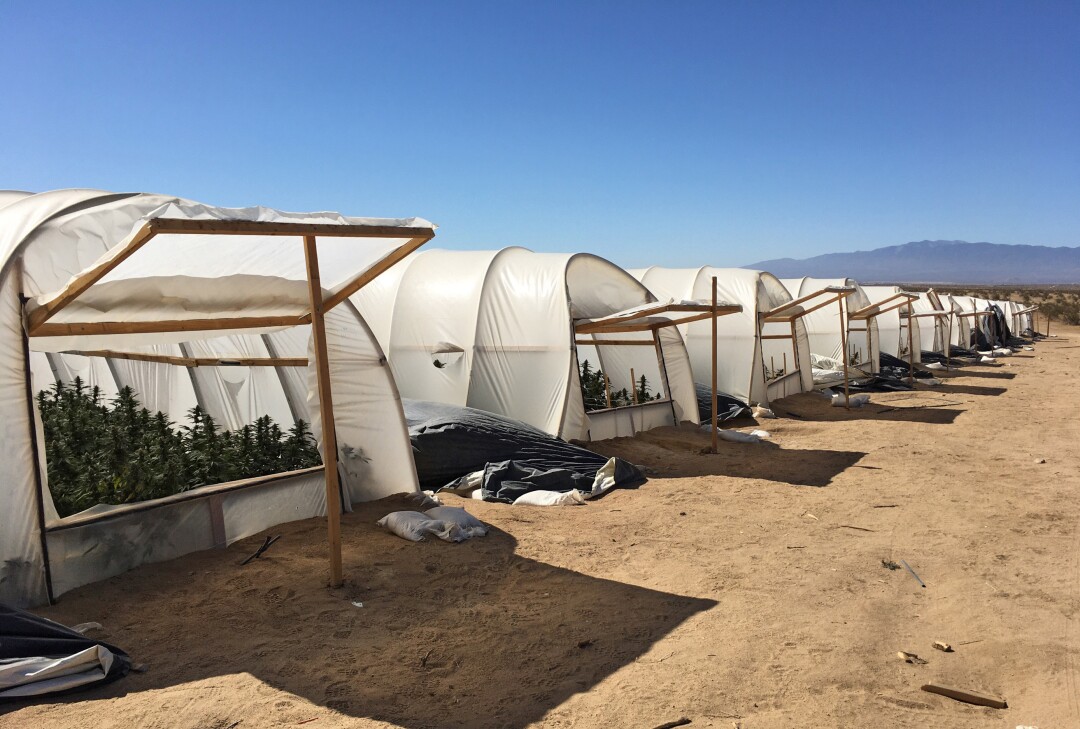
The rise of Mojave Desert pot farming began shortly after California voted to legalize marijuana in 2016. Ever since, black-market growers have flocked to the desert, which offers a near-perfect environment for large-scale farming: endless sunshine, cheap open space and virtually no police. Though desert pot does require enormous amounts of water, growers have discovered that that they can buy or steal all they need.
Bulldozers scrape desert brush and topsoil into tall berms as growers clear space for row after row of tunnel-like greenhouses, from which the pungent scent of cannabis wafts over neighborhoods. In some cases, illegal pot farms sprawl across the desert floor like corporate agricultural compounds, seemingly springing up overnight.
Los Angeles County sheriff’s deputies within the last few monthshave counted 500 such illegal grow sites from the air — a huge jump from the 150 tallied last year. In San Bernardino County, sheriff’s deputies have come across 860 illegal sites. The farms have become so numerous that one outraged resident posted drone footage of one greenhouse after another filling a one-mile stretch of desert in Twentynine Palms.
The spread has coincided with an increase in violence. Though there is no official tally of homicides, The Times found at least five Mojave Desert slayings in 2020 and 2021 that investigators said were related to pot farming, as well as one attempted murder.
In one recent eradication sweep, the Los Angeles County Sheriff’s Department said, authorities seized 373,000 pot plants and more than 16 tons of harvested marijuana with a street value of more than $1 billion — the largest such operation in the department’s history.
The proliferation of an extremely water-intensive crop in a desert environment has heightened fears of water scarcity as well.
In the midst of a worsening drought, growers have stolen water from agricultural wells and aqueducts, or have broken open fire hydrants. So much was stolen from hydrants in late March that the plummeting water pressure compromised firefighting operations. As a result, the Los Angeles County Fire Department ordered the removal of 100 hydrants in the Antelope Valley.
Cannabis cultivators began moving out of California’s redwood forests and into the sun-scorched desert in 2018, two years after voters passed Proposition 64, which reduced the penalty for growing and selling pot from a felony to a misdemeanor.
While some cash-strapped municipalities, such as Desert Hot Springs, have courted legal growers, industrial pot operations have remained prohibited on federal lands and in unincorporated county areas. The boom in black-market farms has occurred in precisely these prohibited areas. Had those growing operations been licensed, state and local governments could have collected millions of dollars in taxes and fees.
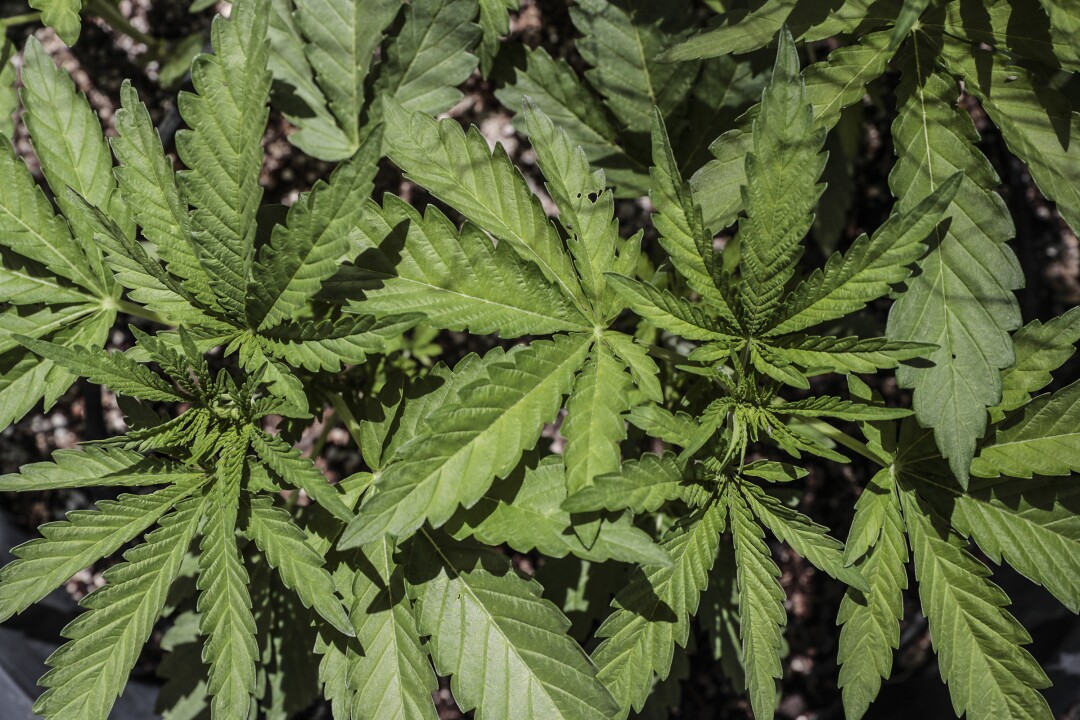
“There’s more black-market marijuana than ever before, much more than prior to Prop. 64,” said William Bodner, special agent in charge of the U.S. Drug Enforcement Administration’s Los Angeles field division.
Many of the illegal grows are run by Mexican, Chinese, Russian, Armenian and Laotian criminal organizations, said Bodner, a 30-year veteran of the agency.
Oil extracted from California weed is used to make popular products such as edibles and vaping cartridges, which are shipped in trucks and cars to legal dispensaries in California and across the country.
Authorities, who say they don’t have the resources to go after all the illegal farms, warn residents and off-roaders to steer clear of those areas. They also say they have more pressing concerns, such as the trafficking of synthetic opioids.
“My No. 1 priority right now is fentanyl and overdose deaths,” Bodner said. “Even if you were going to say, ‘You’re getting 20 more agents,’ guess what? Those 20 agents will go to fentanyl and preventing overdose deaths to our community. That and methamphetamine are our two priorities.”
Although agencies conduct periodic raids in which they hack down marijuana plants and destroy greenhouses with heavy machinery, the growers are quick to resume operations, officials concede.
“We raid a pot farm on Wednesday, and it’s back up and running on Saturday,” said San Bernardino County Sheriff’s Sgt. Rich Debevec.
Law enforcement officers say that in some cases, migrants work at pot farms to pay off their fees for being transported across the U.S.-Mexico border illegally. California legislators have appealed to the state andU.S. attorneys general to step in.
“These grows are often guarded by heavily armed cartels who intimidate local residents into giving up land and water,” wrote several high desert legislators, including state Senate Republican leader Scott Wilk of Saugus. “As law enforcement officials have busted more of these rings, they have also discovered that these operations take advantage of minors and undocumented immigrants by forcing them to work the grows under threat of death or injury.”

On a rugged overlook in Yucca Valley, in San Bernardino County, a middle-aged man in a straw hat stooped as he entered a crude and sultry greenhouse. Inside were rows of plastic drums, each containing a handful of month-old seedlings that would — someday — pay the man’s bills.
“I aim to make about $100,000 a year off of 100 plants — or $1,000 per pound,” said the man, who asked that his name not be used because his marijuana grow was illegal. “That is, if I don’t get busted again.”
It was about a year ago, he said, that he returned from lunch one afternoon to discover “my grow was full of cops using machetes to chop down the plants. Some plants were so big they needed two to three whacks to knock down.” The officers handed the grower a misdemeanor citation punishable with a $500 fine and/or up to six months in jail.
But an even bigger surprise awaited him when he showed up in a courtroom a few months later, and the judge asked him why he was there. “There was no record of my citation in the system,” the grower recalled with a laugh. “For whatever reason, it was never filed. … So, yeah, I’m growing again and hoping for the best.”
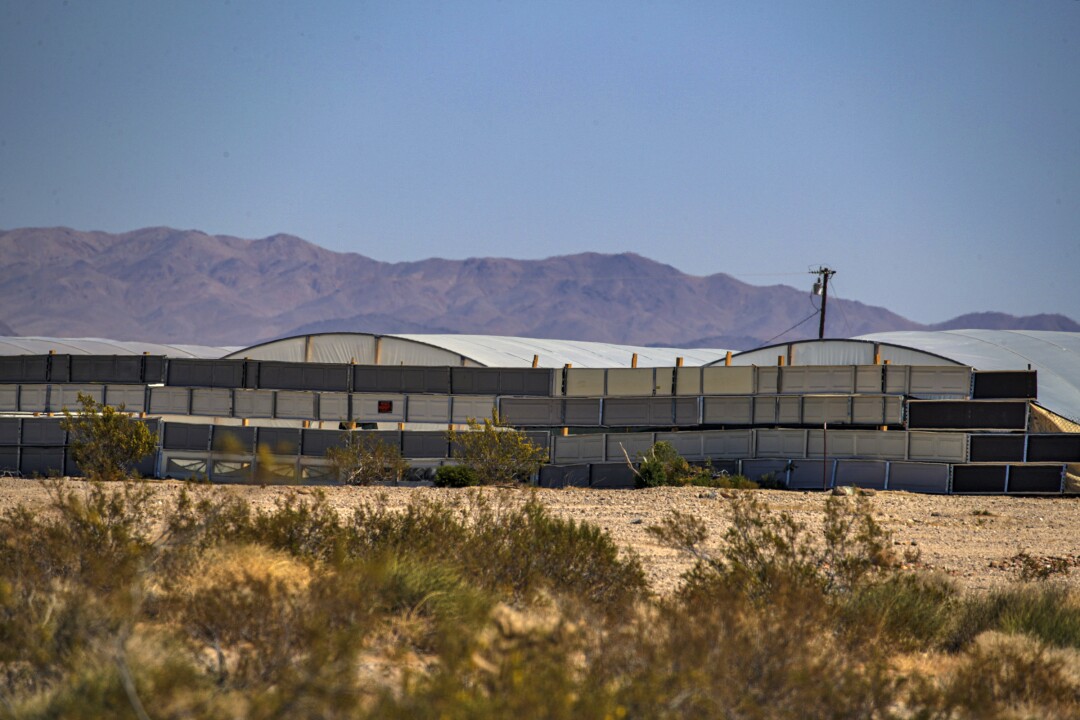
That is precisely the attitude that is fueling the boom in black-market desert farms, some say.
“Due to current state laws and most marijuana crimes being misdemeanors, there is not a huge impact made by criminal prosecution,” said San Bernardino County Sheriff’s Lt. Marc Bracco.
Farms capable of growing 3,000 to 5,000 plants at a time now crowd once-empty tracts of desert near Twentynine Palms. Typically, the farms consist of white hoop tents that shelter plants worth millions of dollars on the black market. Workers, who live on the compounds for months at a time, nourish the crop with fertilizer and plastic drip-irrigation tubes.
“San Bernardino County is the largest and sunniest county in the United States,” said Ryan Verner of Desert Grown Hydroponics in Yucca Valley. “Weed grows really good here year-round.”
In addition to a favorable growing climate, Verner said, the region is crisscrossed with major transportation corridors — including Interstates 10, 215, 15 and 40 — to facilitate distribution.
That kind of talk worries San Bernardino County Supervisor Dawn Rowe.
“Their business is not welcome in our county,” she said. “It’s devastating the desert, raising urgent concerns about quality-of-life issues, groundwater contamination and the environment.”
Rowe said she and other officials want to fund an eradication campaign that “will come down so hard and so often on these cultivations that they won’t be able to survive.”
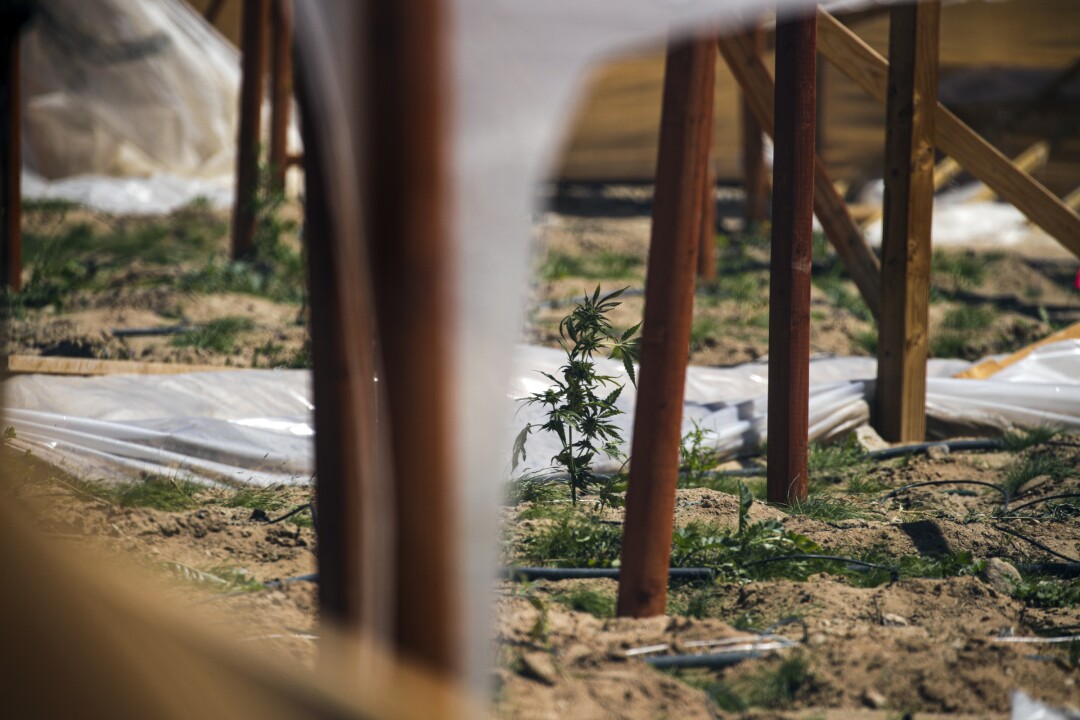
Southern California’s Mojave Desert has always been a refuge for people who resent outside interference — an independent-minded outback of sagebrush plains, volcanic spires and Joshua trees.
But the brazenness of cultivators and the seeming reluctance of governments to direct the money and staff needed to eliminate illegal pot farms have come as a shock to retirees who live in sparsely populated desert areas — places where emergency response times average 20 minutes.
They say that when night falls, floodlights illuminating the largest pot farms make them appear like villages in the distance, and disputes between growers sometimes erupt into gunfire that echoes across the desert.
The presence of desert pot farms appears to have become even more entrenched since last year, when record lightning fires burned through the heart of Northern California’s pot-growing region, destroying farms and tainting surviving plants with wildfire smoke.
“The smell of pot farms smacks me in the face every day,” said Patricia Domay, 80, of the San Bernardino County community of Landers. “It’s like a bad dream. New ones are popping up every day, and there’s not a sheriff’s deputy or code enforcement officer in sight.”
Although advocates of marijuana legalization argued that it would reduce crime, black-market grows throughout the state have seen episodes of violence, and Southern California is no exception. Last year, seven people — mostly recent immigrants from Laos — were gunned down and killed at a marijuana grow in Riverside County.
In the Antelope Valley, at least three killings in the last two years have been connected to marijuana farms. The most recent deaths were those of Ramirez-Gonzalez, whose body was found in March, and a person who was killed a month later during an attempted robbery and shootout at another grow.
Just over the border in Kern County, a Lancaster man was gunned down in his pickup truck last year in an area of several marijuana grows. In San Bernardino County, authorities are still investigating the attempted murder of a man who was shot multiple times last summer at a pot farm in Twentynine Palms.
These days, when people leave home in the high desert, they watch their backs.
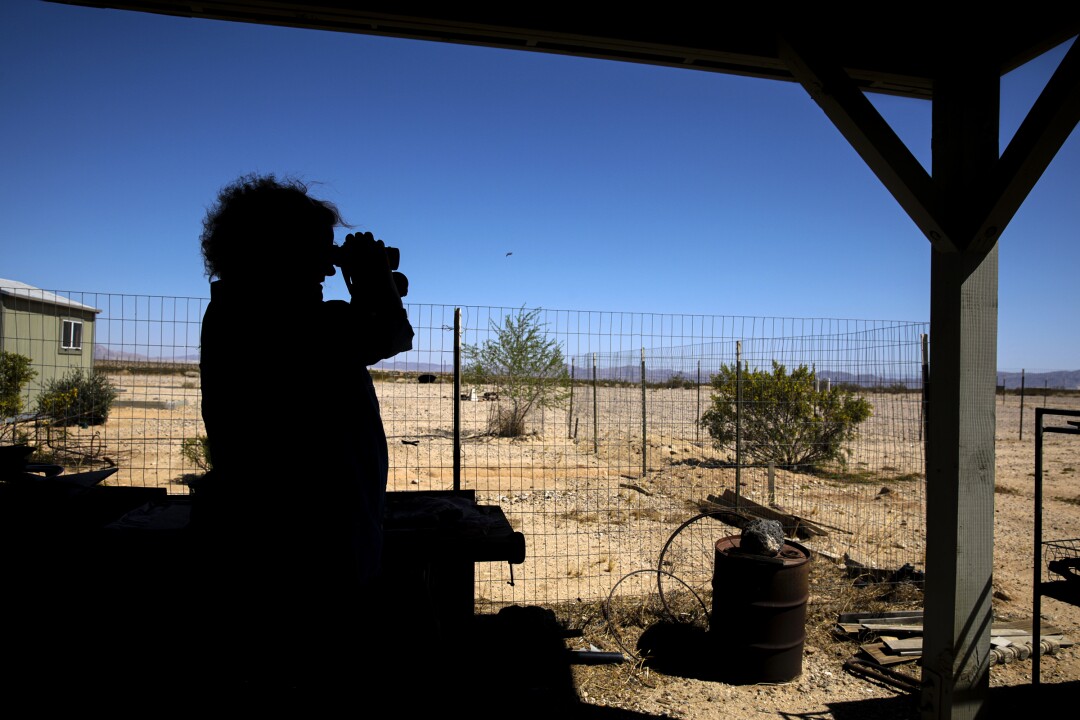
(Irfan Khan / Los Angeles Times)
Take Wonder Valley, a sparsely populated unincorporated enclave in San Bernardino County straddling State Route 62.
During a tour on a recent weekday, Patricia Horwath, a Wonder Valley resident of 23 years, gazed beyond the windshield of her four-wheel drive truck and said, “Straight ahead are just a few of more than 20 illegal grows that have sprouted within a few miles of my home over the past year or so.”
“Some [people] carry guns,” she added, shaking her head in frustration, “and have lookouts who sit in trucks and vans, closely scanning — and even photographing — people and vehicles passing by.”
As she spoke, a man standing behind a tree across the road snapped photos of her vehicle and its passengers.
Then there was the stranger who showed up on her doorstep one day in March with an uncomfortable offer: “Howdy,” he said. “I’ll get right to the point. We need some of your land to grow marijuana.”
Horwath turned him down. In interviews, several other property owners said they had rejected offers of up to $4,000 a month in rent from prospective growers.
Real estate brokers in the area say city dwellers fleeing urban sprawl, combined with cannabis cultivators, are contributing to a surge in property values.
“We’re seeing five-acre parcels sell for record-high prices of more than $20,000,” said Bryan Wynwood, a real estate broker in Joshua Tree. “But that will likely change once the boom wears off and people start becoming concerned about marijuana grows reducing desirability in their desert paradise.”

(Robert Gauthier / Los Angeles Times)
Proposition 64 promised to end the black-market cultivation and sale of marijuana in California communities. It also promised to create jobs and generate hundreds of millions of dollars in tax revenue to cover costs of administration, substance abusetreatment and law enforcement.
Things haven’t quite worked out that way.
Today, the legal pot industry is struggling. As much as 80% of the marijuana sold in California comes from the black market.
For Adam Spiker, executive director of the nonprofit Southern California Coalition, the Southland’s largest marijuana trade association, the transformation of the desert landscape is another sign that “Prop. 64 is failing.”
“There are more illicit pot farms than ever,” he said, “and they are undercutting legal growers so severely that they can’t survive under the law.”
What incentive is there to follow the law, he asked, if it means paying state and federal taxes, getting insurance and meeting mandatory requirements for laboratory testing, packaging and prevailing wages and benefits?
“It’s a real heartbreak, because the intent in reducing the penalty from a felony to a misdemeanor was righteous,” he said. “It could help stop a disproportionate number of people of color from going to prison on marijuana charges.”
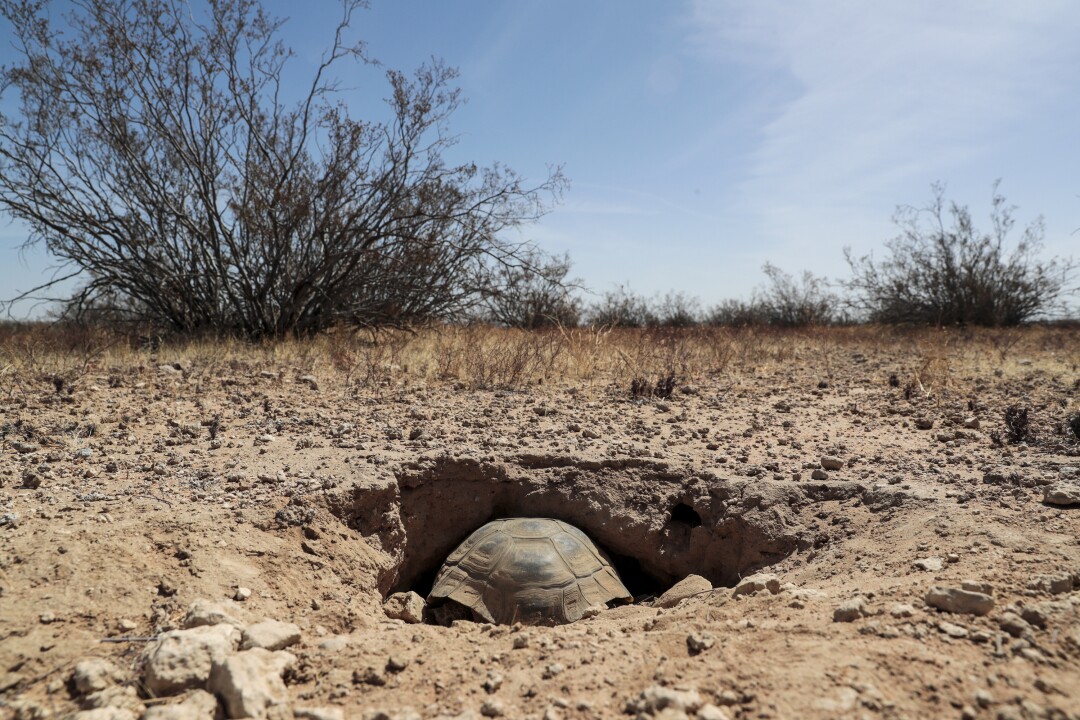
(Robert Gauthier / Los Angeles Times)

As the desert warmed one recent morning about 20 miles north of Barstow, SUVs and trucks bearing sloshing water tanks barreled down a narrow, unpaved road. The vehicles, which were headed to a huge pot farm, streaked through desert tortoise habitat and sent a large cloud of dust billowing over cholla cactus and creosote.

(Robert Gauthier / Los Angeles Times)
Such farms are often difficult to discern at ground level, because they are frequently obscured by large earthen berms and shrubs. Evidence of their presence includes mounds of illegally dumped trash: wooden pallets, food waste, empty fertilizer sacks and plastic and metal containers. Residents complain that they also see tanker trucks siphoning off water from hydrants, aqueducts or neighbors’ wells.
As law enforcement attempts to grapple with the explosive growth of desert pot farms, conservationists say the environmental damage caused by numerous farms growing a water-intensive crop may take decades to repair.
“Large-scale marijuana grows can inflict tremendous damage on desert lands and resources,” said Cody Hanford, deputy executive director of the nonprofit Mojave Desert Land Trust. “In preparation for growing, parcels are often scraped of vegetation, killing both plants and wildlife, including desert tortoise. Deep depressions are dug into the earth, and wells are dug to draw water from aquifers.”
Chemicals such as rodenticides and herbicides, which can be harmful to humans, plants and wildlife, are used with no regulatory oversight, he said. Recently, state wildlife authorities reported that the bodies of two black bears were found at desert pot farms — victims of such poisoning.
Biologists are especially worried about pot farms surrounded by designated “areas of critical environmental concern” and managed by the U.S. Bureau of Land Management.
One such area, where imperiled desert tortoises cling to survival, is in the vicinity of the intersection of State Route 58 and Highway 395. The desert there has become a hive of illegal pot farms.
Alfalfa farmer Mitch Hammack said he was recently dismayed by the sight of a tortoise that had been run over by a vehicle on a remote stretch of road just west of Barstow that runs past at least 17 pot farms.
“I took photographs of that poor animal and gave copies to authorities,” he said. “This problem is only going to get worse.”

(Drug Enforcement Administration)
Longtime residents of the Antelope Valley say drugs have always had a presence here, but what is happening now is different.
Robin Nute, president of the Lake Los Angeles Rural Town Council, said she has lived through a lot in the desert, including a time when her community was littered with methamphetamine labs.
“They never caused no trouble for anybody,” Nute said. “They just blew up a house every now and then. … I was never afraid.”
That’s no longer the case, and Nute said she’s considering moving from the desert.
In April, Rep. Mike Garcia (R-Santa Clarita) stepped aboard a helicopter to investigate the complaints of Antelope Valley residents. The sight of what he said were hundreds of black-market pot farms flourishing in his district left him shaken.
Matters didn’t get any better when he attended a boisterous community meeting in Pearblossom. Residents complained that they had been placing calls to lawmakers and the Sheriff’s Department, only to be ignored. They said they no longer felt safe driving along certain public roads or riding horses past grows protected by untethered guard dogs.
It didn’t help when Garcia acknowledged that even though he’s on the House Appropriations Committee, it could take until December to get more money approved to deal with the grows.
After a few residents shouted that vigilante justice would be faster, Garcia said, “Don’t take matters into your own hands.”
Since then, he and other California Republican members of Congress have demanded that U.S. Atty. Gen. Merrick Garland “address the growing crisis.”
“This problem is not going to go away, and it will only get worse without intervention,” the group wrote in a letter to Garland. “Every day that these criminals continue to operate with impunity hurts our constituents and California as a whole.”
But the idea of a federal law enforcement crackdown on California’s multibillion-dollar marijuana industry worries both legal and illegal growers.
“It scares the hell out of everyone in the business,” said Spiker of the marijuana trade association. “That’s because federal law doesn’t delineate between legal and illegal marijuana — it’s all illegal.”
Times staff writer Matthew Ormseth contributed to this report.
Copyright © 2021, Los Angeles Times

Recent Comments